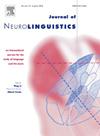基于ERP的通用男性角色名词和德语性别星形所引发的性别表征比较
IF 1.2
3区 心理学
Q2 LINGUISTICS
引用次数: 0
摘要
关于应该使用哪种语言性别形式来引起对所有性别的公平心理表征,一直存在着争论。虽然大多数有性别语法的语言传统上都使用阳性形式来指代人,但大量实证研究表明,这种形式会导致心理表征中的男性偏向。在德语中,有人提出了所谓的 "性别明星"(gender star)形式,作为阳性形式的替代,旨在更好地代表非男性性别身份的人。为了提供有关这一说法的实证数据,我们比较了在参照解析过程中,性别星形与一般意义上的男性形所引起的神经处理机制。在本项ERP研究中,受试者阅读的句子对中,一组人被以两种性别形式之一的角色名词引入,然后被揭示为部分由男性或女性组成。在男性形式之后,对女性(相对于男性)的隐喻引用会导致 P600 范围内的 ERP 振幅增加。与此相反,在使用性别星形式时,男性(与女性)的 P600 波幅增加,尽管时空范围略有不同。因此,本研究的数据表明,性别星形和一般意指男性的形式在参照解析过程中对大脑进行的句法运算提出了部分不同的要求,但最终这两种形式都不会引起德语中男女性别平衡的心理表征。本文章由计算机程序翻译,如有差异,请以英文原文为准。
An ERP-based comparison of gender representations elicited by generic masculine role nouns and the German gender star form
There is an ongoing debate about the linguistic gender forms that should be used to elicit fair mental representations of all genders. While most languages with grammatical gender traditionally use the masculine form to refer to people in a gender-independent way, numerous empirical studies have demonstrated that this form leads to a male bias in mental representations. In German, the so-called gender star form has been proposed as an alternative to the masculine form, aimed at better representing persons with nonmale gender identities. To provide empirical data on this claim, we compared the neural processing mechanisms elicited by the gender star form with those elicited by the generically intended masculine form during reference resolution. Participants in the present ERP study read sentence pairs in which a group of people was introduced with a role noun in one of the two gender forms and then revealed to be partly comprised of men or women. Following the masculine form, anaphoric references to women (vs. men) resulted in an increased ERP amplitude in the P600 range. In contrast, following the gender star form, the P600 amplitude was increased for references to men (vs. women), albeit in a slightly different spatio-temporal range. The present data thus indicate that the gender star form and the generically intended masculine form impose partially different demands on the syntactic operations performed by the brain during reference resolution but that, in the end, neither form elicits gender-balanced mental representations of men and women in German.
求助全文
通过发布文献求助,成功后即可免费获取论文全文。
去求助
来源期刊

Journal of Neurolinguistics
医学-神经科学
CiteScore
3.90
自引率
5.00%
发文量
49
审稿时长
17.2 weeks
期刊介绍:
The Journal of Neurolinguistics is an international forum for the integration of the neurosciences and language sciences. JNL provides for rapid publication of novel, peer-reviewed research into the interaction between language, communication and brain processes. The focus is on rigorous studies of an empirical or theoretical nature and which make an original contribution to our knowledge about the involvement of the nervous system in communication and its breakdowns. Contributions from neurology, communication disorders, linguistics, neuropsychology and cognitive science in general are welcome. Published articles will typically address issues relating some aspect of language or speech function to its neurological substrates with clear theoretical import. Interdisciplinary work on any aspect of the biological foundations of language and its disorders resulting from brain damage is encouraged. Studies of normal subjects, with clear reference to brain functions, are appropriate. Group-studies on well defined samples and case studies with well documented lesion or nervous system dysfunction are acceptable. The journal is open to empirical reports and review articles. Special issues on aspects of the relation between language and the structure and function of the nervous system are also welcome.
 求助内容:
求助内容: 应助结果提醒方式:
应助结果提醒方式:


